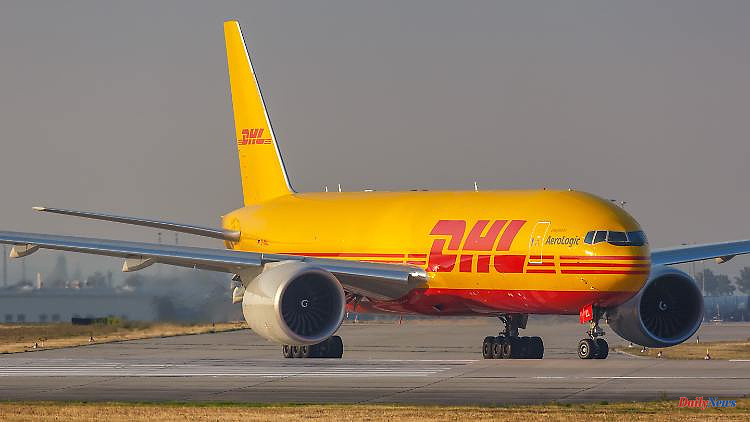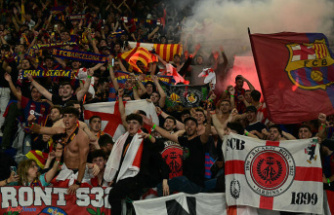On Sunday, Formula 1 drives in Azerbaijan on the Caspian Sea, just a week later it starts in Montreal at the Canadian Grand Prix. 750 tons of materials in six cargo planes. A logistical tour de force for DHL - but still more relaxed than races in Europe.
Spain, Monaco, Azerbaijan, Canada, Great Britain, Austria - in this order Formula 1 is going around the world in these weeks. Six races over eight weekends. After the city race in Monte Carlo on the last weekend in May, the race continues this Sunday in Baku (1 p.m. / Sky and in the live ticker on ntv.de).
Almost 3,500 kilometers as the crow flies separate the Côte d'Azur from Azerbaijan's capital, a huge distance - but logistically for Formula 1 it's almost everyday life and not a problem at all. "It's a very comfortable calendar when you have two weeks between races," says Arjan Sissing, Head of Brand Management at Deutsche Post DHL Group, in the ntv podcast "Learned again".
DHL has been transporting Formula 1 cars and team equipment around the world for almost 40 years. For this she usually needs six Boeing 777 freighters. "We differentiate between sea freight, air freight and, of course, land freight. We transport the so-called non-critical kits by sea, i.e. the materials that are not absolutely necessary for every race. There are no races without cars, but it can be that it's still possible without a rear wall from a team garage," explains Sissing.
At races in Europe, which make up the majority of the Formula 1 calendar, all containers are transported by road. Almost 300 articulated trucks bring all the material from A to B. Planes are only used in exceptional cases, when trucks break down, explains Sissing.
As a rule, however, the road is the more cumbersome, in Europe mainly because of Great Britain. "Since Brexit, European races have been less complicated than overseas races," says Sissing. "Most of the teams are based in England. And because of Brexit, the transport is similar to overseas races in terms of customs and other conditions." Border traffic to Great Britain is also difficult because "we have to go through a tunnel with 40 trucks". That is critical. "Not all trucks get through there so slippery."
With a two-week cycle, the freight is also taken immediately to the next racetrack. But then you have more time to set everything up.
Back-to-back races in Europe are logistically even more of a challenge than overseas races. Loading the materials onto the cargo plane and sending them across the pond to the Middle East or Australia is much more convenient, says Sissing. Especially since the logistics for overseas races are organized centrally by Formula 1.
Immediately after the end of the race, the cars are disassembled and everything is packed. This usually takes seven to eight hours. The materials are then loaded onto pallets and trucked to the airport. The chassis are transported in special containers. "Ultimately, everything that isn't nailed down is dismantled. And then the chassis are put into the containers and taken to the next race track," explains Sissing.
About 750 tons will be loaded and transported to Montreal immediately after the race in Azerbaijan on Sunday. 9,000 kilometers from the Caspian Sea to Canada. Once there, construction begins immediately. There's no time to lose, the training sessions are already on Friday.
Last season, Formula 1 put the teams and the logistics to the test. There were two so-called "triple headers" on the calendar, i.e. three consecutive Grand Prix without a race-free weekend in between. From Spa in Belgium we went to Zandvoort on the Dutch North Sea coast and from there to Monza for the Italian Grand Prix. The second "triple header" saw races in Mexico, Brazil and Qatar.
This season there is another triple pack. The races in Spa, Zandvoort and Monza will be held back-to-back again. As the logistics service provider for Formula 1, is DHL involved in creating the race calendar? "We are included, but we are certainly not authoritative, it must be said in fairness. We try to bring in our experience," says Sissing in the podcast.
At DHL, a separate department with around 35 employees takes care of the logistics of Formula 1. A tough job, exhausting every year. Only after the last race of the season - which has been in Abu Dhabi for years - do the colleagues have "three or four weeks off," reports Sissing. Early in the new year, the test drives in Barcelona will continue. "We can't sit still for long when it comes to Formula 1, but we love doing it," says the DHL brand manager.
So far, the logistics group has always managed to deliver the freight to the next race track on time. But that has its price - especially in these times. Rising inflation, plus scarce freight capacities for sea and air freight, as Corona and various lockdowns have thrown the system out of step. The Formula 1 team bosses, above all Red Bull's Christian Horner, complain that freight costs have risen sharply. He is therefore in favor of increasing the budget limit for Formula 1 teams.
22 races will be held this year - just like last season. Actually it should have been 23. However, because of the Russian war of aggression, the Sochi Grand Prix was removed from the calendar. Without replacement - to the relief of all involved. That saves money and energy.












